MENU
The Electronic Scholarly Publishing Project: Providing access to classic scientific papers and other scholarly materials, since 1993. More About: ESP | OUR CONTENT | THIS WEBSITE | WHAT'S NEW | WHAT'S HOT
Comparative Timelines
The ESP Timeline (one of the site's most popular features) has been completely updated to allow the user to select (using the timeline controls above each column) different topics for the left and right sides of the display.
Select:
New Left Column
New Left Column
Dates
Decade
New Right Column
New Right Column
(no entry for this year)
1780
Massachusetts abolishes slavery and grants African-American men the right to vote.
A freedom clause in the Massachusetts constitution is interpreted as an abolishment of slavery. Massachusetts enfranchises all men regardless of race.
Delaware makes it illegal to enslave imported Africans.
Pennsylvania begins gradual emancipation.
Great Hurricane of 1780 — the deadliest Atlantic hurricane on record — kills 20,000 to 30,000 in Caribbean.
 William Herschel discovers first binary star, Xi Ursae Majoris.
William Herschel discovers first binary star, Xi Ursae Majoris.
Abraham Gottlob Werner asserts that all rocks have been deposited by a primordial ocean. This "Neptunian" view is accepted with little question.
(no entry for this year)
1781
 Mozart's opera "Idomeneo" premieres in Munich.
Mozart's opera "Idomeneo" premieres in Munich.
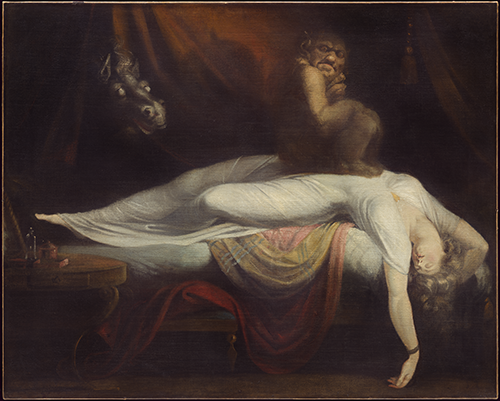 Painting by Henry Fuseli: The Nightmare shows a woman in deep sleep with her arms thrown below her, and with a demonic and apelike incubus crouched on her chest. The painting's dream like and haunting erotic evocation of infatuation and obsession was a huge popular success. After its first exhibition, at the 1782 Royal Academy of London, critics and patrons reacted with horrified fascination and the work became widely popular, to the extent that it was parodied in political satire, and an engraved version was widely distributed. In response, Fuseli produced at least three other versions.
Painting by Henry Fuseli: The Nightmare shows a woman in deep sleep with her arms thrown below her, and with a demonic and apelike incubus crouched on her chest. The painting's dream like and haunting erotic evocation of infatuation and obsession was a huge popular success. After its first exhibition, at the 1782 Royal Academy of London, critics and patrons reacted with horrified fascination and the work became widely popular, to the extent that it was parodied in political satire, and an engraved version was widely distributed. In response, Fuseli produced at least three other versions.
Los Angeles, California, is founded by 54 settlers, including 26 of African ancestry.
 Immanuel Kant publishes Critique of Pure Reason, a fundamental work of modern philosophy.
Immanuel Kant publishes Critique of Pure Reason, a fundamental work of modern philosophy.
 Pierre François André Méchain discovers M80 (globular cluster in Scorpio).
Pierre François André Méchain discovers M80 (globular cluster in Scorpio).
Johan Carl Wilcke introduces the concept of SPECIFIC HEAT.
 Coloumb's Théorie des machiones simple (Theory of simple machines) is a study of friction.
Coloumb's Théorie des machiones simple (Theory of simple machines) is a study of friction.
(no entry for this year)
1782
Britain signs agreement recognizing U.S. independence.
Congress approves Great Seal of U.S. and the eagle as its symbol.
(no entry for this year)
1783
American Revolution Ends Britain and the infant United States sign the Peace of Paris treaty.
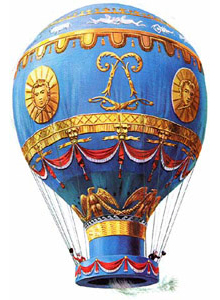 Joseph and Jacques Montgolfier make first public balloon flight.
Joseph and Jacques Montgolfier make first public balloon flight.
Earthquakes ravage Calabria in Italy, killing 30,000.
The amateur British astronomer John Michell proposes the theoretical idea of an object massive enough that its gravity would prevent even light from escaping (which has since become known as a black hole). He realizes that such an object would not be directly visible, but could be identified by the motions of a companion star if it was part of a binary system. A similar idea was independently proposed by the Frenchman Pierre-Simon Laplace in 1795.
 Horace-Bénédict de Saussure's Essais sur l'hygromé (Essay on measuring humidity) describes how to construct a hygrometer from human hair that can measure relative humidity.
Horace-Bénédict de Saussure's Essais sur l'hygromé (Essay on measuring humidity) describes how to construct a hygrometer from human hair that can measure relative humidity.
(no entry for this year)
1784
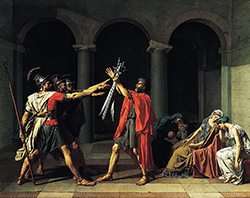 Painting by Jacques-Louis David: Oath of the Horatii (French: Le Serment des Horaces), is now on display in the Louvre in Paris. The painting immediately became a huge success with critics and the public, and remains one of the best known paintings in the Neoclassical style. It depicts a scene from a Roman legend about a dispute between two warring cities, Rome and Alba Longa. Instead of the two cities sending their armies to war, they agree to choose three men from each city; the victor in that fight will be the victorious city. From Rome, three brothers from a Roman family, the Horatii, agree to end the war by fighting three brothers from a family of Alba Longa, the Curiatii. The three brothers, all of whom appear willing to sacrifice their lives for the good of Rome, are shown saluting their father who holds their swords out for them. Aside from the three brothers depicted, David also represents, in the bottom right corner, a woman crying whilst sitting down. She is Camilla, a sister of the Horatii brothers, who is also betrothed to one of the Curiatii fighters, and thus she weeps in the realisation that, in any case, she will lose someone she loves. The painting is considered a paragon of neoclassical art.
Painting by Jacques-Louis David: Oath of the Horatii (French: Le Serment des Horaces), is now on display in the Louvre in Paris. The painting immediately became a huge success with critics and the public, and remains one of the best known paintings in the Neoclassical style. It depicts a scene from a Roman legend about a dispute between two warring cities, Rome and Alba Longa. Instead of the two cities sending their armies to war, they agree to choose three men from each city; the victor in that fight will be the victorious city. From Rome, three brothers from a Roman family, the Horatii, agree to end the war by fighting three brothers from a family of Alba Longa, the Curiatii. The three brothers, all of whom appear willing to sacrifice their lives for the good of Rome, are shown saluting their father who holds their swords out for them. Aside from the three brothers depicted, David also represents, in the bottom right corner, a woman crying whilst sitting down. She is Camilla, a sister of the Horatii brothers, who is also betrothed to one of the Curiatii fighters, and thus she weeps in the realisation that, in any case, she will lose someone she loves. The painting is considered a paragon of neoclassical art.
John Jay becomes first U.S. Secretary of State.
Russian trappers established a colony on Kodiak Island, Alaska.
Congress narrowly defeats Thomas Jefferson's proposal to ban slavery in new territories after 1800.
Treaty of Paris ratified, officially ending the American Revolutionary War
Congress of the Confederation ratifies the Treaty of Paris on January 14, 1784, formally ending the Revolutionary War.
John Wesley charters Methodist Church.
Historian and naturalist Cosimo Alessandro Collini publishes a description of the first known pterosaur.
George Atwood accurately determines the acceleration of a free-falling body.
Charles Willson Peale establishes a natural history museum in Philadelphia, one of the first successful American museums.
(no entry for this year)
1785
New York frees all slaves who served in the Revolutionary Army.
First balloon flight across English Channel (Jean-Pierre Blanchard and John Jeffries).
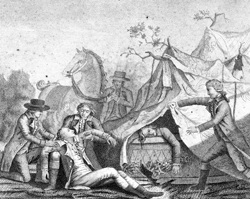 French balloonists Jean-François Pilatre de Rozier and Jules Romain are killed when their Royal Balloon crashes near Boulogne, France, June 15, 1785, in what is considered the first aerial disaster.
French balloonists Jean-François Pilatre de Rozier and Jules Romain are killed when their Royal Balloon crashes near Boulogne, France, June 15, 1785, in what is considered the first aerial disaster.
Napoleon Bonaparte (16) graduates from the military academy in Paris (42nd in a class of 51).
 Lazzaro Spallanzani performs artificial insemination on a dog.
Lazzaro Spallanzani performs artificial insemination on a dog.
 In his Theory of the Earth, James Hutton explains the principle of uniformitarianism: all geological features can be explained by changes that can be observed now, taking place over very long periods of time.
In his Theory of the Earth, James Hutton explains the principle of uniformitarianism: all geological features can be explained by changes that can be observed now, taking place over very long periods of time.
 Couloumb makes precise measurements of the forces of attraction and repulsion between charged bodies and between magnetic poles, using a torsion balance, demonstrating conclusively that electric charge and magnetism obey inverse-square laws like that of gravity. He also discovers that electrically charged bodies discharge spontaneously. In the 20th century, it is found that cosmic radiation is responsible for this discharge.
Couloumb makes precise measurements of the forces of attraction and repulsion between charged bodies and between magnetic poles, using a torsion balance, demonstrating conclusively that electric charge and magnetism obey inverse-square laws like that of gravity. He also discovers that electrically charged bodies discharge spontaneously. In the 20th century, it is found that cosmic radiation is responsible for this discharge.
(no entry for this year)
1786
 Mozart's opera, The Marriage of Figaro, premieres in Vienna.
Mozart's opera, The Marriage of Figaro, premieres in Vienna.
 Frederick the Great, King of Prussia, dies.
Frederick the Great, King of Prussia, dies.
(no entry for this year)
1787
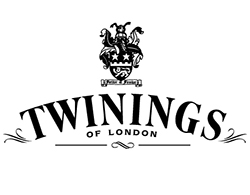 Twining's Tea creates a logo that is still in use today, making it the world's oldest, continuous use logo. The founder of Twinings was Thomas Twining from Painswick, Gloucestershire in England. He opened Britain's first known tea room at No. 216 Strand, London, in 1706; it still operates today.
Twining's Tea creates a logo that is still in use today, making it the world's oldest, continuous use logo. The founder of Twinings was Thomas Twining from Painswick, Gloucestershire in England. He opened Britain's first known tea room at No. 216 Strand, London, in 1706; it still operates today.
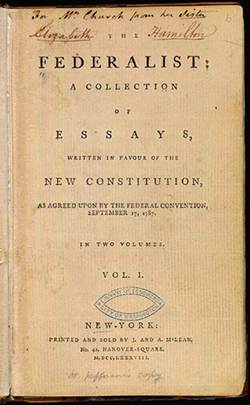 Federalist Papers published, calls for ratification of Constitution. The Federalist (later known as The Federalist Papers) is a collection of 85 articles and essays written (under the pseudonym Publius) by Alexander Hamilton, James Madison, and John Jay promoting the ratification of the United States Constitution. Seventy-seven were published serially in the Independent Journal and the New York Packet between October 1787 and August 1788. A compilation of these and eight others, called The Federalist: A Collection of Essays, Written in Favour of the New Constitution, as Agreed upon by the Federal Convention, September 17, 1787, was published in two volumes in 1788 by J. and A. McLean. The collection's original title was The Federalist; the title The Federalist Papers did not emerge until the 20th century. This book should be carefully read by anyone with an interest in American democracy.
Federalist Papers published, calls for ratification of Constitution. The Federalist (later known as The Federalist Papers) is a collection of 85 articles and essays written (under the pseudonym Publius) by Alexander Hamilton, James Madison, and John Jay promoting the ratification of the United States Constitution. Seventy-seven were published serially in the Independent Journal and the New York Packet between October 1787 and August 1788. A compilation of these and eight others, called The Federalist: A Collection of Essays, Written in Favour of the New Constitution, as Agreed upon by the Federal Convention, September 17, 1787, was published in two volumes in 1788 by J. and A. McLean. The collection's original title was The Federalist; the title The Federalist Papers did not emerge until the 20th century. This book should be carefully read by anyone with an interest in American democracy.
Constitutional convention opens at Philadelphia, George Washington presiding.
The Northwest Ordinance bans slavery in the Northwest Territory (what becomes the states of Ohio, Indiana, Illinois, Michigan, and Wisconsin). The ordinance together with state emancipation laws create a free North.
Austrian emperor Jozef II bans children under 8 from labor.
 Herschel discovers Enceladus, a moon of Saturn, and Titania and Oberon, moons of Uranus.
Herschel discovers Enceladus, a moon of Saturn, and Titania and Oberon, moons of Uranus.
 Jacques-Alexandre Charles shows that different gases expand by the same amount for a given rise in temperature (Charles Law).
Jacques-Alexandre Charles shows that different gases expand by the same amount for a given rise in temperature (Charles Law).
Thomas Jefferson publishes Notes on the State of Virginia refuting Buffon's claim that America's harsh, moist climate stunts the growth of its inhabitants. He also addresses the issue of race, describing Native Americans favorably, but African slaves unfavorably.
(no entry for this year)
1788
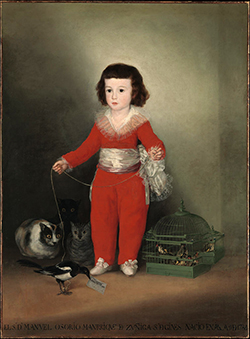 Painting by Francisco de Goya: Manuel Osorio Manrique de Zúñiga, also known as Goya's Red Boy. Vicente Joaquin Osorio de Moscoso y Guzmán (1756–1816), Count of Altamira, had hired Goya for several family portraits. Altamira held many titles and was also a director of the Banco de San Carlos. In 1786, after painting several portraits of the court, Goya was nominated painter to Charles III. This painting, from 1787–88, is of Altimira's youngest son, Manuel, who was born in April 1784 and died at age eight on June 12, 1792.
Painting by Francisco de Goya: Manuel Osorio Manrique de Zúñiga, also known as Goya's Red Boy. Vicente Joaquin Osorio de Moscoso y Guzmán (1756–1816), Count of Altamira, had hired Goya for several family portraits. Altamira held many titles and was also a director of the Banco de San Carlos. In 1786, after painting several portraits of the court, Goya was nominated painter to Charles III. This painting, from 1787–88, is of Altimira's youngest son, Manuel, who was born in April 1784 and died at age eight on June 12, 1792.
Maryland votes (December 23) to cede a ten-square-mile area for District of Columbia.
New York City becomes first capital of US.
The Massachusetts General Court (legislature), following an incident in which free blacks were kidnapped and transported to the island of Martinique, declares the slave trade illegal and provides monetary damages to victims of kidnappings.
Captain Arthur Phillip forms English colony at Sydney, Botany Bay, New South Wales, Australia.
 Kant publishes Critique of Practical Reason.
Kant publishes Critique of Practical Reason.
Juan-Bautista Bru mounts the first relatively accurate fossil reconstruction of an extinct animal from South America. Georges Cuvier classifies it as a giant sloth.
(no entry for this year)
1789
US Congress passes Federal Judiciary Act, creating a six-person Supreme Court.
Bourbon Whiskey is first created by Elijah Craig in Bourbon, Kentucky.
 George Washington becomes the first president of the United States.
George Washington becomes the first president of the United States.
 Fletcher Christian leads Mutiny on HMS Bounty and Captain William Bligh. Mutineers from the Bounty settle on Pitcairn Island.
Fletcher Christian leads Mutiny on HMS Bounty and Captain William Bligh. Mutineers from the Bounty settle on Pitcairn Island.
 Former slave Olaudah Equiano publishes his memoirs, and he travels in Britain lecturing against slavery.
Former slave Olaudah Equiano publishes his memoirs, and he travels in Britain lecturing against slavery.
The fall of the Bastille marks the beginning of the French Revolution.
 Gilbert White's The Natural History and Antiquities of Selborne, a series of notes about animal and plant life in Selborne, England, is the first recognizable work of ecology. It goes through about 300 different editions and is still in print today.
Gilbert White's The Natural History and Antiquities of Selborne, a series of notes about animal and plant life in Selborne, England, is the first recognizable work of ecology. It goes through about 300 different editions and is still in print today.
 Johann Wolfgang Goethe's Versuch, die Metamorphose der Pflanzen zu erklären (Attempt to explain the metamorphosis of plants) claims incorrectly that all plant structures are modified leaves, but clearly espouses evolution.
Johann Wolfgang Goethe's Versuch, die Metamorphose der Pflanzen zu erklären (Attempt to explain the metamorphosis of plants) claims incorrectly that all plant structures are modified leaves, but clearly espouses evolution.
French polymath Antoine Lavoisier publishes a paper on French geology defining peacefully deposited pelagic sediments and violently deposited littoral sediments. He argues that these sediments illustrate a fluctuating sea level on an ancient planet.
The French chemist Antoine-Laurent de Lavoisier definitively states the Law of Conservation of Mass (although others had previously expressed similar ideas, including the ancient Greek Epicurus, the medieval Persian Nasir al-Din al-Tusi and the 18th Century scientists Mikhail Lomonosov, Joseph Black, Henry Cavendish and Jean Rey), and identifies (albeit slightly incorrectly) 23 elements which he claims can not be broken down into simpler substances.
ESP Quick Facts
ESP Origins
In the early 1990's, Robert Robbins was a faculty member at Johns Hopkins, where he directed the informatics core of GDB — the human gene-mapping database of the international human genome project. To share papers with colleagues around the world, he set up a small paper-sharing section on his personal web page. This small project evolved into The Electronic Scholarly Publishing Project.
ESP Support
In 1995, Robbins became the VP/IT of the Fred Hutchinson Cancer Research Center in Seattle, WA. Soon after arriving in Seattle, Robbins secured funding, through the ELSI component of the US Human Genome Project, to create the original ESP.ORG web site, with the formal goal of providing free, world-wide access to the literature of classical genetics.
ESP Rationale
Although the methods of molecular biology can seem almost magical to the uninitiated, the original techniques of classical genetics are readily appreciated by one and all: cross individuals that differ in some inherited trait, collect all of the progeny, score their attributes, and propose mechanisms to explain the patterns of inheritance observed.
ESP Goal
In reading the early works of classical genetics, one is drawn, almost inexorably, into ever more complex models, until molecular explanations begin to seem both necessary and natural. At that point, the tools for understanding genome research are at hand. Assisting readers reach this point was the original goal of The Electronic Scholarly Publishing Project.
ESP Usage
Usage of the site grew rapidly and has remained high. Faculty began to use the site for their assigned readings. Other on-line publishers, ranging from The New York Times to Nature referenced ESP materials in their own publications. Nobel laureates (e.g., Joshua Lederberg) regularly used the site and even wrote to suggest changes and improvements.
ESP Content
When the site began, no journals were making their early content available in digital format. As a result, ESP was obliged to digitize classic literature before it could be made available. For many important papers — such as Mendel's original paper or the first genetic map — ESP had to produce entirely new typeset versions of the works, if they were to be available in a high-quality format.
ESP Help
Early support from the DOE component of the Human Genome Project was critically important for getting the ESP project on a firm foundation. Since that funding ended (nearly 20 years ago), the project has been operated as a purely volunteer effort. Anyone wishing to assist in these efforts should send an email to Robbins.
ESP Plans
With the development of methods for adding typeset side notes to PDF files, the ESP project now plans to add annotated versions of some classical papers to its holdings. We also plan to add new reference and pedagogical material. We have already started providing regularly updated, comprehensive bibliographies to the ESP.ORG site.
ESP Picks from Around the Web (updated 06 MAR 2017 )
Old Science

Weird Science

Treating Disease with Fecal Transplantation
Fossils of miniature humans (hobbits) discovered in Indonesia

Dinosaur tail, complete with feathers, found preserved in amber.
Astronomy

Mysterious fast radio burst (FRB) detected in the distant universe.